A conserved aromatic lock for the tryptophan rotameric switch in TM-VI of seven-transmembrane receptors
- PMID: 19920139
- PMCID: PMC2823539
- DOI: 10.1074/jbc.M109.064725
A conserved aromatic lock for the tryptophan rotameric switch in TM-VI of seven-transmembrane receptors
Abstract
The conserved tryptophan in position 13 of TM-VI (Trp-VI:13 or Trp-6.48) of the CWXP motif located at the bottom of the main ligand-binding pocket in TM-VI is believed to function as a rotameric microswitch in the activation process of seven-transmembrane (7TM) receptors. Molecular dynamics simulations in rhodopsin demonstrated that rotation around the chi1 torsion angle of Trp-VI:13 brings its side chain close to the equally highly conserved Phe-V:13 (Phe-5.47) in TM-V. In the ghrelin receptor, engineering of high affinity metal-ion sites between these positions confirmed their close spatial proximity. Mutational analysis was performed in the ghrelin receptor with multiple substitutions and with Ala substitutions in GPR119, GPR39, and the beta(2)-adrenergic receptor as well as the NK1 receptor. In all of these cases, it was found that mutation of the Trp-VI:13 rotameric switch itself eliminated the constitutive signaling and strongly impaired agonist-induced signaling without affecting agonist affinity and potency. Ala substitution of Phe-V:13, the presumed interaction partner for Trp-VI:13, also in all cases impaired both the constitutive and the agonist-induced receptor signaling, but not to the same degree as observed in the constructs where Trp-VI:13 itself was mutated, but again without affecting agonist potency. In a proposed active receptor conformation generated by molecular simulations, where the extracellular segment of TM-VI is tilted inwards in the main ligand-binding pocket, Trp-VI:13 could rotate into a position where it obtained an ideal aromatic-aromatic interaction with Phe-V:13. It is concluded that Phe-V:13 can serve as an aromatic lock for the proposed active conformation of the Trp-VI:13 rotameric switch, being involved in the global movement of TM-V and TM-VI in 7TM receptor activation.
Figures
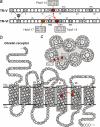
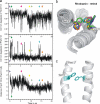
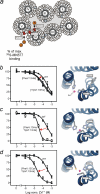


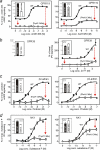
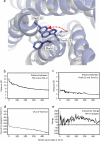
Similar articles
-
PheVI:09 (Phe6.44) as a sliding microswitch in seven-transmembrane (7TM) G protein-coupled receptor activation.J Biol Chem. 2012 Dec 21;287(52):43516-26. doi: 10.1074/jbc.M112.395137. Epub 2012 Nov 7. J Biol Chem. 2012. PMID: 23135271 Free PMC article.
-
Identification of an efficacy switch region in the ghrelin receptor responsible for interchange between agonism and inverse agonism.J Biol Chem. 2007 May 25;282(21):15799-811. doi: 10.1074/jbc.M609796200. Epub 2007 Mar 19. J Biol Chem. 2007. PMID: 17371869
-
Ghrelin receptor inverse agonists: identification of an active peptide core and its interaction epitopes on the receptor.Mol Pharmacol. 2006 Sep;70(3):936-46. doi: 10.1124/mol.106.024422. Epub 2006 Jun 23. Mol Pharmacol. 2006. PMID: 16798937
-
Molecular mechanism of 7TM receptor activation--a global toggle switch model.Annu Rev Pharmacol Toxicol. 2006;46:481-519. doi: 10.1146/annurev.pharmtox.46.120604.141218. Annu Rev Pharmacol Toxicol. 2006. PMID: 16402913 Review.
-
Ligand binding and micro-switches in 7TM receptor structures.Trends Pharmacol Sci. 2009 May;30(5):249-59. doi: 10.1016/j.tips.2009.02.006. Epub 2009 Apr 16. Trends Pharmacol Sci. 2009. PMID: 19375807 Review.
Cited by
-
The arginine of the DRY motif in transmembrane segment III functions as a balancing micro-switch in the activation of the β2-adrenergic receptor.J Biol Chem. 2012 Sep 14;287(38):31973-82. doi: 10.1074/jbc.M112.348565. Epub 2012 Jul 26. J Biol Chem. 2012. PMID: 22843684 Free PMC article.
-
Signal transmission through the CXC chemokine receptor 4 (CXCR4) transmembrane helices.Proc Natl Acad Sci U S A. 2016 Aug 30;113(35):9928-33. doi: 10.1073/pnas.1601278113. Epub 2016 Aug 19. Proc Natl Acad Sci U S A. 2016. PMID: 27543332 Free PMC article.
-
Critical hydrogen bond formation for activation of the angiotensin II type 1 receptor.J Biol Chem. 2013 Jan 25;288(4):2593-604. doi: 10.1074/jbc.M112.395939. Epub 2012 Dec 7. J Biol Chem. 2013. PMID: 23223579 Free PMC article.
-
Structural Basis for Agonistic Activity and Selectivity toward Melatonin Receptors hMT1 and hMT2.Int J Mol Sci. 2023 Feb 2;24(3):2863. doi: 10.3390/ijms24032863. Int J Mol Sci. 2023. PMID: 36769183 Free PMC article.
-
A Complete Assessment of Dopamine Receptor- Ligand Interactions through Computational Methods.Molecules. 2019 Mar 27;24(7):1196. doi: 10.3390/molecules24071196. Molecules. 2019. PMID: 30934701 Free PMC article.
References
-
- Schwartz T. W., Rosenkilde M. M. (1996) Trends Pharmacol. Sci. 17, 213–216 - PubMed
-
- Schwartz T. W., Frimurer T. M., Holst B., Rosenkilde M. M., Elling C. E. (2006) Annu. Rev. Pharmacol. Toxicol. 46, 481–519 - PubMed
-
- Pin J. P., Kniazeff J., Liu J., Binet V., Goudet C., Rondard P., Prézeau L. (2005) FEBS J. 272, 2947–2955 - PubMed
-
- Hubbell W. L., Altenbach C., Hubbell C. M., Khorana H. G. (2003) Adv. Protein Chem. 63, 243–290 - PubMed
Publication types
MeSH terms
Substances
LinkOut - more resources
Full Text Sources
Molecular Biology Databases

